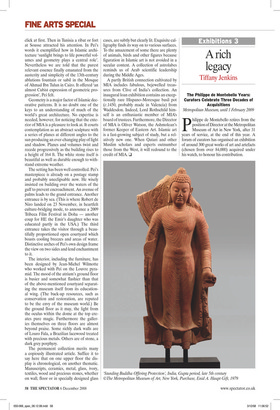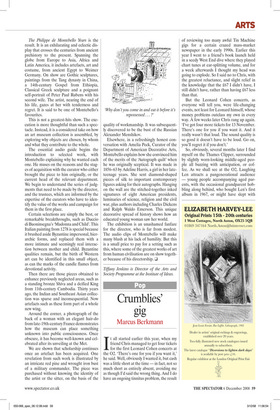A rich legacy
Tiffany Jenkins
The Philippe de Montebello Years: Curators Celebrate Three Decades of Acquisitions Metropolitan Museum, until 1 February 2009
Philippe de Montebello retires from the position of Director at the Metropolitan Museum of Art in New York, after 31 years of service, at the end of this year. A forum of curators has organised an exhibition of around 300 great works of art and artefacts (chosen from over 84,000) acquired under his watch, to honour his contribution. The Philippe de Montebello Years is the result. It is an exhilarating and eclectic display that crosses the centuries from ancient prehistory to the present. Spanning the globe from Europe to Asia, Africa and Latin America, it includes artefacts, art and costume, from ancient Egypt to Weimer Germany. On show are Gothic sculptures, paintings from the Tang dynasty in China, a 14th-century Gospel from Ethiopia, Classical Greek sculpture and a poignant self-portrait of Peter Paul Rubens with his second wife. The artist, nearing the end of his life, gazes at her with tenderness and regret. It is said to be one of Montebello’s favourites.
This is not a greatest-hits show. The execution is more thoughtful than such a spectacle. Instead, it is a considered take on how an art museum collection is assembled, by exploring why objects are chosen, by whom and what they contribute to the whole.
The essential audio guide begins the introduction to selected work, with Montebello explaining why he wanted each one. He muses on the reasons and the stages of acquisition with the curator who either brought the piece to him originally, or the current head of the relevant department. We begin to understand the series of judgments that need to be made by the director, and the trustees, which are informed by the expertise of the curators who have to identify the value of the works and campaign for them in the first place.
Certain selections are simply the best, or remarkable breakthroughs, such as Duccio di Buoninsegna’s ‘Madonna and Child’. This Italian painting from 1278 is special because it brushed aside Byzantine impersonal, hierarchic forms, and replaced them with a more intimate and seemingly real interaction between mother and child. Byzantine qualities remain, but the birth of Western art can be identified in this small object, as can the marks of the candle flames from devotional activity.
Then there are those pieces obtained to enhance previously neglected areas, such as a standing bronze Shiva and a deified King from 11th-century Cambodia. Thirty years ago, the Indian and Southeast Asian collection was sparse and inconsequential. Now artefacts such as these form part of a whole new wing.
Around the corner, a photograph of the back of a woman with an elegant hair-do from late-19th-century France demonstrates how the museum can place something unknown into public consciousness. Once obscure, it has become well-known and celebrated after its unveiling at the Met.
We are shown that scholarship continues once an artefact has been acquired. One revelation from such work is illustrated by an intricate red pine and wrought iron bust of a military commander. The piece was purchased without knowing the identity of the artist or the sitter, on the basis of the quality of workmanship. It was subsequently discovered to be the bust of the Russian Alexander Menshikov.
Elsewhere, in a refreshingly honest conversation with Amelia Peck, Curator of the Department of American Decorative Arts, Montebello explains how she convinced him of the merits of the ‘Autograph quilt’ when he was originally sceptical. It was made in 1856–63 by Adeline Harris, a girl in her lateteenage years. She sent diamond-shaped pieces of silk to important contemporary figures asking for their autographs. Hanging on the wall are the stitched-together inked signatures of eight American presidents, luminaries of science, religion and the civil war, plus authors including Charles Dickens and Ralph Waldo Emerson. This unique decorative spread of history shows how an educated young woman saw her world.
The exhibition is an unashamed fanfare for the director, who is far from modest. The audio clips of Montebello will make many blush at his lack of humility. But this is a small price to pay for a setting such as this, where some of the greatest works of art from human civilisation are on show together because of his directorship. ❑ Tiffany Jenkins is Director of the Arts and Society Programme at the Institute of Ideas.



















































































 Previous page
Previous page